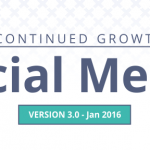Losing Followers On Social Media: When You Should(n’t) Worry
December 7, 2015
 It’s completely natural to use “how many followers / likers have we got?” as a key metric for evaluating how well your social media accounts are doing. We’d always recommend focusing more on direction of travel (fancy talk for “is that number going up or down“!) than absolute numbers (have a look here to find out why it’s SO not all about the number).
It’s completely natural to use “how many followers / likers have we got?” as a key metric for evaluating how well your social media accounts are doing. We’d always recommend focusing more on direction of travel (fancy talk for “is that number going up or down“!) than absolute numbers (have a look here to find out why it’s SO not all about the number).
But if that number suddenly goes down rather than up, how concerned should you be?
Is it a disaster to lose followers or likers?
As with so many things in social media, “it depends“. And the main thing it depends on is what industry sector you’re in, and the type of relationship your business will typically have with a customer. This is often overlooked when businesses set their social media strategy, and particularly when looking at performance metrics, but it’s absolutely fundamental to how you can expect your audience to develop. To explain:
The relationship lifecycle – and why it matters
“Customer journey” is a term that was red hot in marketing, and particularly in Public Sector modernisation projects, a few years ago. Maybe not so much these days, but it’s a really good concept to understand, and it’s very straight forward. It just means thinking about how and when your customers’ relationship with you is developed, from the first time they become aware of you to the point where they hand over cold hard cash, and beyond. How do they find out about you? When do you first hear from them? What contact do you have with them after that? What happens after they buy?
The key thing I want to consider here is the “What happens after they buy” part.
Why? Because some businesses can reasonably hope to have a relationship with their customers which will last a lifetime, or close to: examples might include supermarkets and leisure facilities. There are others which, while not quite in the “lifetime” category, should be able to expect repeat custom if they do a good job: clothing retailers, holiday resorts, photographers, car dealers.
At the other end of the spectrum, there are some businesses where, once a customer has bought your product or service, it’s extremely or relatively unlikely that they’re going to buy from you again. Driving instructors are a great example of this. For many people, wedding services providers are another.
If you’re in the kind of sector where this is the case, it’s far from all bad news, though; those products and services are often associated with intense interest in the topic, if only for a relatively short space of time, and your clients are often great passionate advocates.
Brides-to-be are probably the biggest stereotype for going through a phase of talking about little else on social media, but most sixth formers also know who everyone else’s driving instructor is; and for the period that they’re involved, they have a big appetite for both consuming content related to the subject, and discussing it with others.
Having said that, that phase will pass. Maybe not immediately; newlyweds probably retain an interest in “how everyone else is doing it” for perhaps 6-12 months after the event, but eventually they are going to move on. And at that point, they are unlikely to want to go on receiving content from you, and will very likely unfollow. This is no reflection at all on the quality of your social media presence, it’s just a fact of life, and one that you need to allow for when you’re analysing your statistics.
Bear in mind, too, that you may get a false “surge” in unfollowers for the same reason: you began recruiting your social media audience at a point in time, and depending on which techniques you use to build that audience, they may all be at a very similar stage in their journey. Which means many of them may hit the point of disinterest simultaneously, giving you a spike in unfollowers which can be very worrying but is actually totally explicable!
When you SHOULD worry about losing followers
Most businesses are going to fall somewhere in between the driving instructor and the supermarket. A customer might change car brands for many reasons, or stop using a particular holiday resort or travel company because they now have several small children and are looking for something catering specifically to that. So it’s reasonable to assume that even if your social media presence is fantastic, your followers will fluctuate over time, and even more so if you recruited a large proportion of them together via a particular method.
But there certainly are times when a drop in followers is a warning flag. Some of those are:
– Over a reasonable period (6 months or more) you are losing a significant number of followers, or you are losing more than you are gaining.
– You see a sharp peak in Unfollowers after a change of approach – a new content strategy, tone, or much more frequent posting, for example.
– The losses are from a particular demographic that you want to target. You won’t always know this, but a periodic review of your Facebook Insights will flag up any major change in demographic, and this can be seen on LinkedIn analytics also.
If you’re seeing any of the above, it might be time for a review of what you’ve been posting, how often, and / or how you’re recruiting new followers.
Digital & Social Articles on Business 2 Community
(35)













